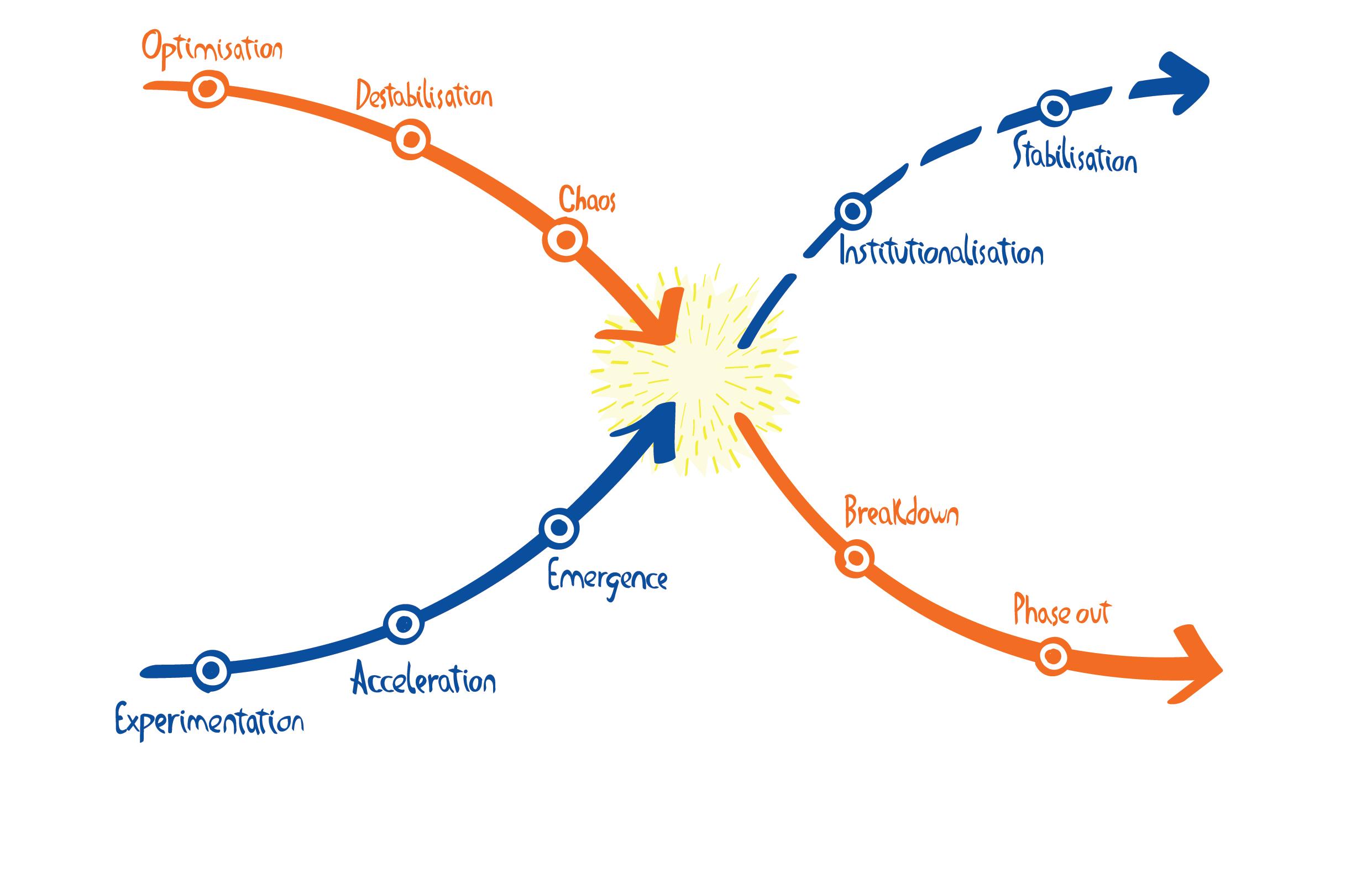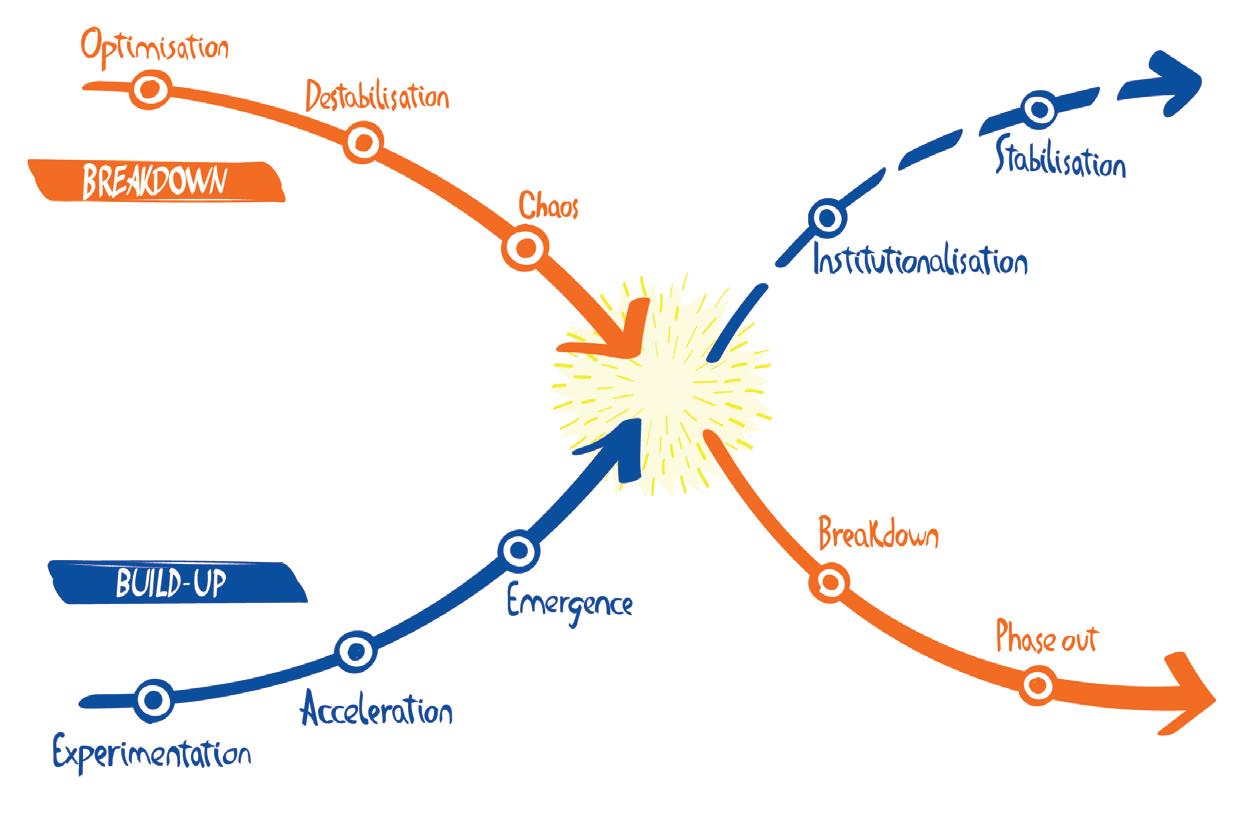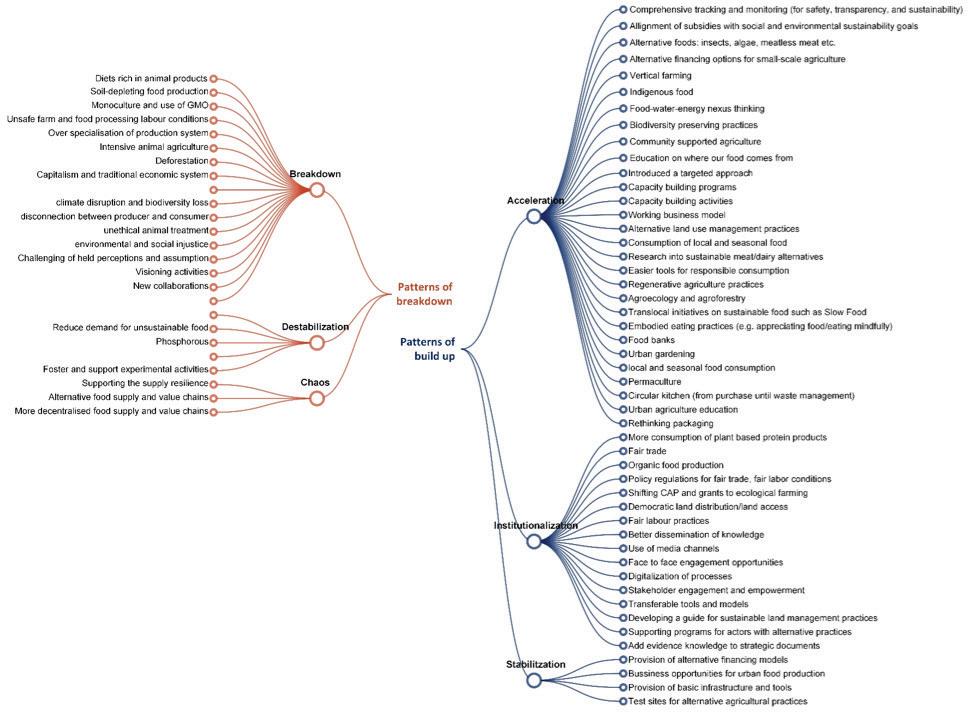
5 minute read
THE X-CURVE
from X curve transition
by Jeroen Boon
What is the X-Curve?
Transitions are fundamental changes in the culture, structure and practices of societal systems. The X-Curve is a visual tool aimed at creating a richer understanding of the transition dynamics within society or a specific context (e.g. neighbourhood, city, region, etc.). It creates a common language and understanding of the societal dynamics currently at play.
Advertisement
The X-Curve is a powerful tool for:
◎ Understanding systems: make transition dynamics understandable as a visual process with the two basic patterns of build-up and breakdown, their underlying dynamics and their potential interactions.
◎ Awareness and priority setting: introduce systemic change into broader societal processes. Develop and communicate a shared vision with selected sector partners and stakeholders, as well as enabling a discussion to establish a common agenda.
◎ Supporting decision-making and experiments: jointly identify interventions as well as strategies, resources and instruments to create an enabling environment for systemic change. This can take place at different phases of the policy process, such as design, implementation or even monitoring and learning.
◎ Manage learning and institutional change: enable transformative change in governmental policies and markets paying attention to the learning processes and reflexive capabilities of actors.
How to apply it to your project?
Context. The X-Curve is very suitable for application in multi-stakeholder settings aimed at jointly exploring the design of alternative actions to support system change.
When? It can be applied at any point during a project's development. However, its application in a project's early stages can help in understanding priority areas, while its use in intermediate stages can provide an opportunity for sense-making, the harvesting of learning, as well as reflecting on new practices and priorities.
Where? In practice, it can be applied in co-creation workshops or selfreflection exercises where the X-Curve functions as a sense-making tool to explore potential interventions as part of collectively created narratives. The X-Curve provides a starting point to explore the transition dynamics present in each domain. Its interpretation, however, is highly dependent on perspective: the image may differ from person to person. Trigger questions can help to think how the X-Curve can contribute to discussions of different aspects and multiple understandings of project developments.
• What do I see happening in society?
• What is going on with the sector where I am working? What is happening in other sectors?
• Where do I position myself, my projects, and other ongoing actions?
• What are the relations between all of them? What are the potential synergies?
• Who are the main actors fostering transformative change?
• What are the resources available?
• Which areas deserve more attention? And what would I like to work on?
Transition Dynamics

Transitions imply deep systemic change unfolding over a long time but with a distinctively non-linear and chaotic pattern in which accelerated and accumulated incremental changes take place. Transition implies a a ‘creation vs destruction’ duality that is simultaneous to the process of generation and anchoring of new, alternative practices and structures, as well as questioning, destabilising, and breaking down existing unsustainable practices and structures. These transition dynamics can be described by two interrelated patterns: patterns of breakdown and patterns of build-up.
Patterns of breakdown
Societal systems (mobility, food, energy, etc.) function well for a long time. Progress is achieved through continuous optimisation and improvement. However, path dependency favours incremental or 'step-by-step' improvements that before led to optimisation and now constitute a lock-in. The more that is invested in them, the more difficult it becomes to change. The patterns of breakdown occur as part of a changing ‘landscape’ (exogenous pressures such as climate change or digitalisation) where destabilisation gradually develops: unrest and tensions within the targeted system and emerging doubts about its long-term sustainability. That can be the starting point of a phase of sudden loss of security, collapse of companies, political intervention, or acute crises: chaos. This eventually leads to the phasing out of parts of the original targeted system.
Patterns of build up
The underlying patterns of build-up are about shaping alternative ways of thinking, working, and organising. Such 'transformative innovations' often arise experimentally, far from the regime: they are radical, alternative, and marginal and fall outside the social norm. These can be entrepreneurs working on electric cars, but also people shifting to bikes, platforms providing shared mobility, and new cultural norms that frame cars not as the pinnacle of freedom but as an unwelcome necessity to do shopping or commute to work. But over time, such alternatives become cheaper, more visible, better understood and organised, and the process of diffusion accelerates: more and more people are joining in and recognise their potential. From the selforganising capacity of people, new structures, routines and organisational forms gradually emerge.
Insights on patterns of breakdown and patterns of build-up from two agro-food initiatives
This figure shows a collection of elements harvested during the application of the X-Curve in two projects: Food System led by DRIFT and System and sustainable Approach to virTuous interaction of Urban and Rural LaNdscapes – SATURN – led by Climate-KIC. These elements illustrate the type of actions and interventions that can be associated with different stages from both patterns.

An example of build-up and breakdown patterns on the circular economy
In the transition to a circular economy, do we mainly see activity around experimentation and acceleration, or are there also signs of institutionalisation? And how much emphasis is still put on optimising the current system (improving it), rather than phasing out what we already know is unsustainable in the long term? In the dynamic of build-up and breakdown, the two patterns reinforce or counteract each other and there is never a single transition, let alone an unambiguous outcome. However, the different dimensions of transitions and the sub-patterns of build-up and breakdown do provide a basis for making a rough estimate of the 'state of transition’, its direction and speed.
That 'state of transition' can provide a basis for strategy development aimed at anticipating subsequent phases, responding to (un)desired dynamics, and exploring possible futures. So, for the circular economy, given what we just identified as important transition dynamics, are we focussing on the right things, or should we shift attention to more effectively steer and accelerate upwards and downwards dynamics?
Take the example of the transition to a circular economy in The Netherlands. When systems structures and processes are still stable and optimisation works fine, people who work on system change are misunderstood and easy to marginalise. For a long time, the circular economy was only seen as a complementary step by focusing on waste management and recycling, and few people believed it could really impact the overall economic system any time soon. Now, as more destabilisation occurs, and the end of pipe solutions based on recycling start to fail, more people are becoming interested in experimenting with alternative products, processes, and services by seriously challenging the traditional linear business models and, subsequently, increasing acceptance and visibility of circular economy options.
While signs of destabilisation are growing, there are disruptive situations and changes (i.e. chaos) affecting the economic and political systems. However, the value in value chains is redefined by companies shifting to new business models by providing a service rather than a product and, by doing so, increasing the opportunities for upscaling integrated offers in the value chain. Standards are then introduced to support the institutionalisation of successful practices on new circular products and services while regulations impose new rules and limitations to support the phase-out of unwanted practices. From this perspective, transitions are therefore also very social processes: expectations, feelings, ideals, interests, and perceptions are very decisive in tempo and dynamism. By changing the expectations of what a circular economy should be and leading principles by which it functions (circular business models, environmental quality, systems perspective, intensive service added value), further progress for systemic change is facilitated. The shift in expectations and mindset can contribute to the creation of shared meanings in future scenarios and related strategic interventions.




